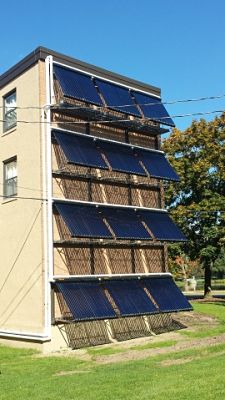
Solar Panels at ΄σΟσ΄«Γ½ University
From introducing energy-saving initiatives in buildings to minimizing landfill waste to encouraging the purchase and use of local food in dining facilities, the sustainability movement at ΄σΟσ΄«Γ½ has made great strides this past year.
Now, things are really heating up after achieving one more goal in the universityβs β implementing solar thermal energy. 100 Broad Street (the Creative Arts House) is being equipped with 12 solar panels that will provide the majority of the residential houseβs energy.
Currently, the other 16 residence spaces on Broad Street are solely heated with fuel oil No. 2 β an expensive and relatively dirty source of energy that produces carbon emissions.
The solar panels, on the other hand, will reduce ΄σΟσ΄«Γ½βs carbon footprint by capturing the sunβs energy to generate hot water for daily activities such as taking showers, washing dishes, and using faucets.
According to John Pumilio, director of sustainability, the project makes good sense for ΄σΟσ΄«Γ½βs financial and .
With state rebates and fuel cost savings of nearly $2,600 a year, Pumilio expects the project to have a 10-year return in investment.
βThe cost of fuel oil is rising and unpredictable, so if it jumps to $3.50 a gallon, all of a sudden the project has a much quicker payback. Renewable energy projects make us more resilient. We are not at the whim of increasing costs of fossil fuels, especially since thereβs a lot of uncertainty and risk involved with them. Thereβs not as much risk as to whether the sun is going to come up tomorrow,β he says.
Although Hamilton is not the sunniest of places, Pat Leamy, project manager in the Facilities Department, explains that hot, direct sunlight is not completely necessary to heat the water year-round.
βTen years ago, not having as much sun used to be a major issue. The technology has improved quite a bit. The collectors are more efficient now. Most of the technology came from NASA,β said Leamy, who worked closely with Joe Bello and Paul Fick of the Facilities Department.
For the cold and overcast January mornings when students are showering, the building might rely on fossil fuel for most of the heating. However, when taking into account the heat intensity in the warmer months, the Sustainability Office hopes to eliminate about half of the houseβs fuel oil consumption β a conservative estimate, according to Pumilio.
The solar panel installation is one of included in the . After implementing several energy-saving projects and investing in carbon offsets, Pumilio estimates that the university has reduced its overall footprint to about 5,000 tons, which is considerably less than the campusβ baseline of 17,000 in 2009.
According to Pumilio, ΄σΟσ΄«Γ½ has one of the lowest campus carbon footprints in the country and is in a very good position to achieve carbon neutrality by 2019.